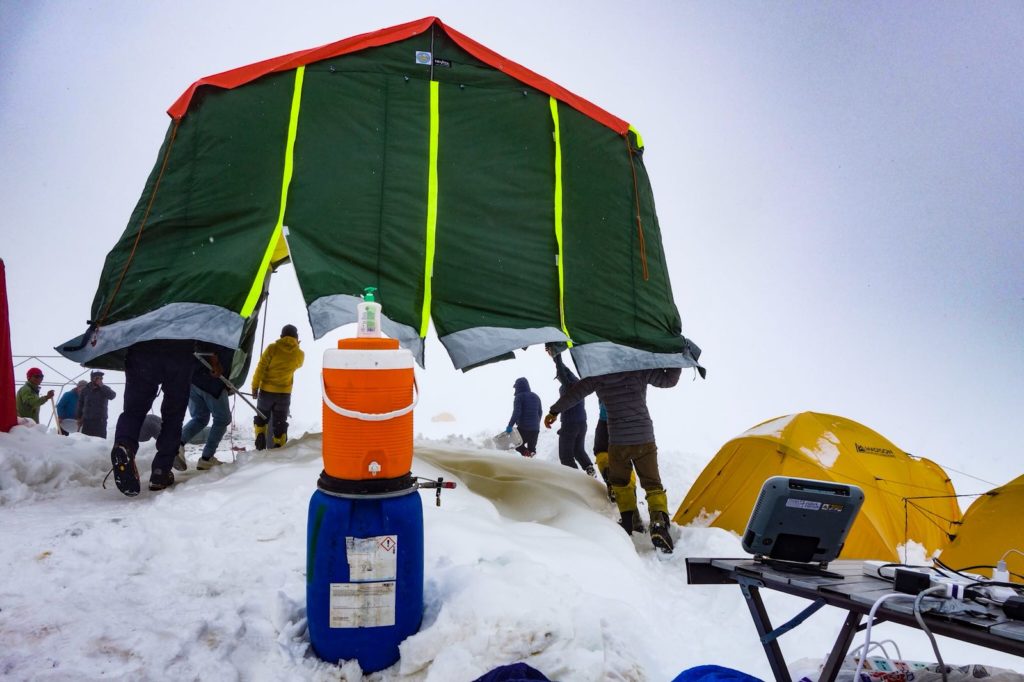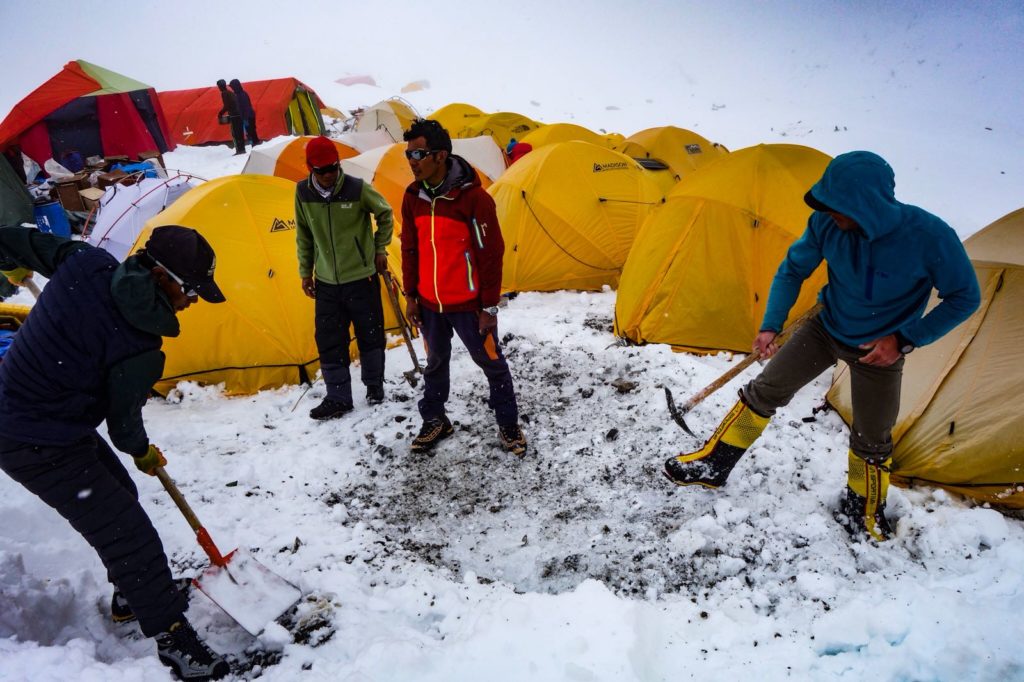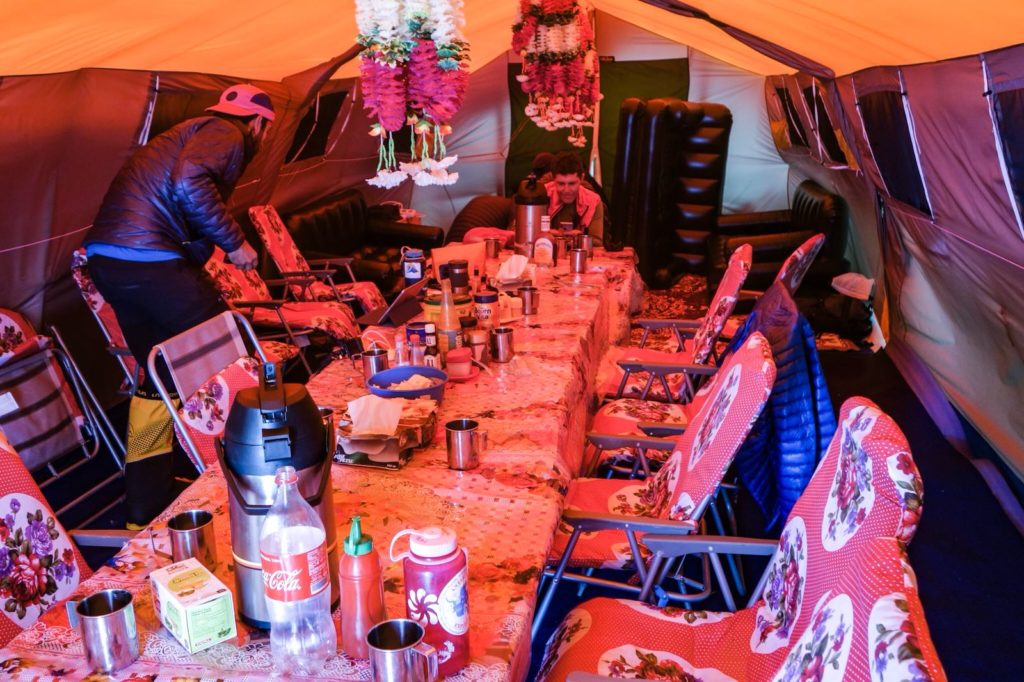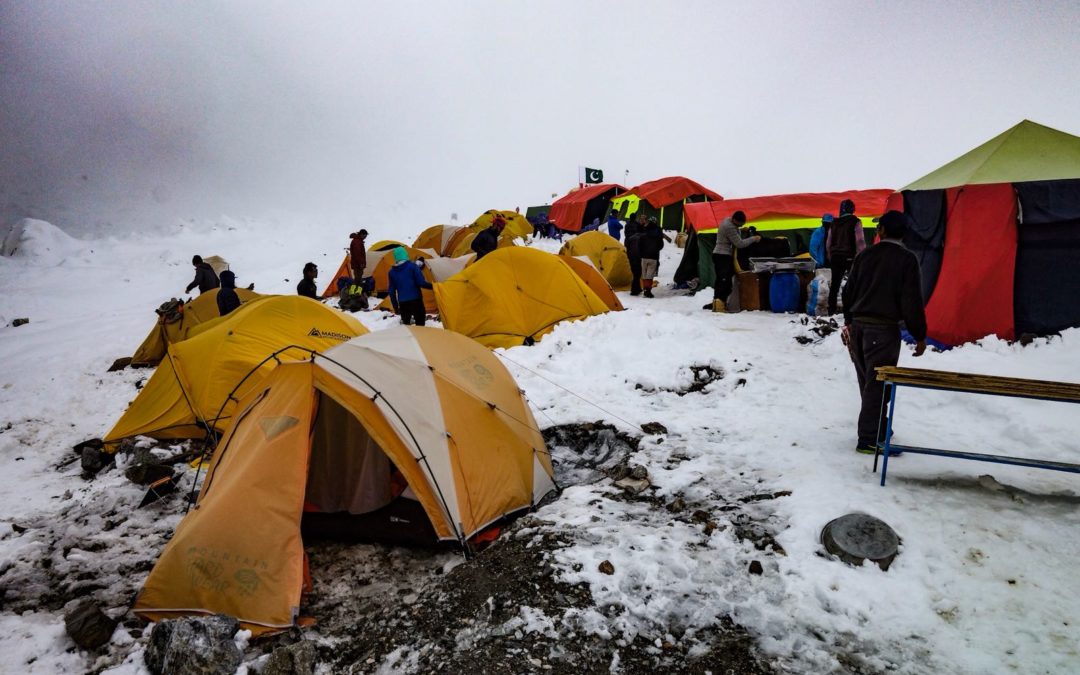Today was a relatively boring day, at least from a reader’s standpoint. It was our latest breakfast so far, as is normal with rest days, and we spent the majority of our time reorganizing camp. When we arrived yesterday, there was so much snow that we set everything up as quickly as possible and knew that it would only be temporary. We rebuilt our dining tent, cook tent, communications tent and 70% of our personal tents. Most had been built on heavy snow and it is inevitable that this would melt away, causing unstable foundations. Thanks to the lighter snowfall, we had the opportunity to dig out new foundations, directly into the glacier, and build a more permanent home.
We literally picked up the temporary dining tent and moved it about 50 ft away. As you can see from the picture, it is probably the most luxurious accommodations in the Karakoram Range. You are probably wondering how we got blowup couches, chairs, faux flower chandeliers and all of our amenities, which is why I see this first rest day as the perfect opportunity to elaborate upon the logistics of K2.

Working smarter, not harder when moving the dining tent
Most of you know that I have spent my entire professional career in the supply chain and logistics industry with C.H. Robinson and have a true passion for the problem solving that success requires. What most of you don’t know is that today, June 30th, is actually my 10 year anniversary with C.H. Robinson, so I feel that this journal is quite appropriate for the occasion. While I miss my colleagues, I feel very blessed to have the opportunity to be employed by a company that would allow me to spend my 10th Anniversary at 16,400 ft on the side of a mountain in Pakistan.

Geoff and Siddhi working hard to cut out a tent platform from the glacial ice
Alright, enough of the snappiness… I know a lot of people were amazed by the logistics that were necessary for an expedition to Everest but they pale in comparison to what is necessary to support a K2 climb. There are a few primary reasons that this is the case; the trek to Basecamp is twice as long as Everest, yaks are not indigenous to Pakistan, there is almost no infrastructure to speak of on the trek in.
We have the largest team on K2 for the 2018 season and account for 24 of the 87 permitted K2 climbers. To support our 10 climbers, 3 guides and 10 sherpas we have the support of 230+ porters. For a refresher, porters are people that make a living by carrying heavy loads on their backs. Each porter has a weight limit of 25 kgs (55 lbs) but that does not include the weight of their personal items. For those that love statistics, here are some fun facts about our support expedition…
Porters & Mules
Our team is supported by 230+ porters and 45 mules. They are responsible for carrying all provisions and equipment needed for our expedition. In total, the porters and mules will ferry more than 25,000 lbs of provisions and gear for our 24 person team throughout the course of our expedition!
- 77 Porters departed ahead of our team to deliver our basecamp equipment.
- 120+ Porters accompany our team on the trek to basecamp, carrying gear and provisions.
- 38 Porters accompany our team but carry food for the 120+ gear carrying porters.
- 6 Porter Chiefs who coordinate the efforts of our porters and manage pay.
- Porters all reside within a 3 hour travel radius of Askole.
- 45 Mules (Also horses and donkeys) each carrying 100kg of gear and provisions.
- Mules are sourced from Askole families, each of which usually only owns 1 animal.
- Mules cost a family approximately $2,000 USD but will garner a $600 fee for 1 trip to Basecamp with each making approximately 5 trips each year.
Provisions & Equipment
To feed and equip this small army, there are some staggering figures and most of these numbers are only for the trek in. Additional provisions, specifically food items, will be regularly ferried up throughout our time on the mountains.
- 21 live chickens just for the trek to K2BC.
- 110 lbs of potatoes for the trek.
- 450 lbs of kitchen equipment
- 2 Buffalo: 1 buffalo will provide meat for the team for 2 weeks with the first arriving with us and the second following in 2 weeks.
- 4 Goats: Meat for porters on the trek to K2BC.
- 1,400 eggs to begin the expedition with more to follow as needed.
Those numbers might sound crazy to you but seeing them in reality is even more mind blowing! No amount of pictures can do them justice but I do my best to share in the experience. Hopefully, this helps to paint a picture of how serious of an undertaking it is to attempt to climb a mountain like K2. Last but not least, don’t take for granted all of the hard work that it takes to provide you with all the amenities that you have in your life. Logistics make the world go round! Here’s to 10 more exciting years!

Our dining tent exemplifies the finer things in life at 16,400 ft





John, where are the potatoes from? Are they grown in Pakistan or shipped in? Potatoes lovers and growers want to know. Your farfar would have been checking that out immediately. And how are they prepared? Maybe with a nice buffalo gravy?
But, wow, that is so amazing. It almost makes me want to be there, just to see how an expedition like this works. Almost.
And, congratulations on 10 years!
John- congratulations on your 10th anniversary with C.H. Robinson. And hats off to their HR department for recognizing your potential for reaching “great heights” in logistics! As I read the detailed account and scale of your “K2 Village”, it actually reminded me of the Lewis and Clark expedition and all the planning and prep they had to do. You’ve just taken it all to a new, high-tech level. Fascinating!
Farmor.
John does that “Dining Tent” remind you of our kitchen table? I do think the view we have here is a little different and of course today the temperature is 102 F. here. We will think about you around your table in your little village.
Congrats on the 10 year anniversary at CHR! Very cool that they support you the way that they do. Looking back 10 years who would have thought you would be 1) celebrating 10 years at CHR and 2) doing it on K2!
John, happy to 10 year anniversary! I am in Montenegro with my family on vacation while reading this with my family. We all wish you well on K2!
Thank you for all the information. I have always been amazed by the amount of work and planning required long before an extraordinary adventure like this actually begins. You must have started planning this shortly after getting back home from Everest.
As an engineer I am somewhat obsessed with numbers. I am sure you will cover this later but, You have 10 on your team, 10 sherpas and 3 guides. How many of you actually go all the way to the peak? I assume only 10.
How far back do you leave the sherpas and guides?.
10 years with your company, congratulations. What a way to start year 11.
John, Thank you for sharing this amazing information. May peace and safety be with you, your team, and everyone on the mountain.
Congrats on 10 years with CHR! The logistics insights are fascinating, hope you share more as your trip continues. Praying for good weather for all of you.
Happy 10 years John! Seems like yesterday I was training you on the system count management. Have a great time on your journey.